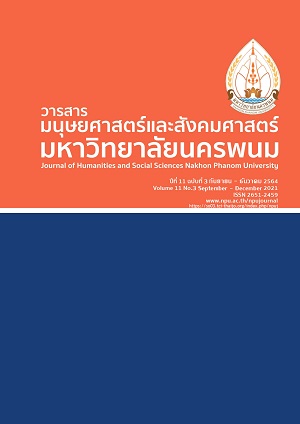The Recommendation System for Learning Activities According to Learning Styles Analyzed by Data Mining
Main Article Content
Abstract
This research has four purposes including 1) to analyze the variables related to learners' learning style 2) to select a learning style classification model 3) to develop a recommendation system for learning activities according to learning style analyzed by data mining and 4) to compare learners' study achievement between the study whose learning activities are organized by the recommendation system for learning activities and the study whose learning activities are organized by an instructor. For variables related to learning style, 12 experts’ opinions are analyzed by using a questionnaire for experts' opinions on variables related to learning style. Learning style questionnaires were developed based on the principle of Honey and Mumford, which are collected from 1,328 undergraduate students studying at Nakhon Ratchasima Rajabhat University. These samplings are applied to create 14 learning classification models. In order to evaluate the recommendation system for learning activities, the satisfactions of the system are collected from 5 experts. For comparing study achievement, the experiment is conducted with 2 groups of students. The first group consists of 28 students studying by the system-based organizing the learning activities whereas the second group consists of 28 students studying by an instructor-based organizing’s learning activities. The research results are as follows. Firstly, there are 7 variables related to the learning style : gender, faculty, year, GPA, highest score subject, previous qualification and previous study plans. Secondly, the most efficient model is the one created by J48graft algorithm, which has an accuracy of 82.23%. This results are obtained by testing the performance of learning style classification models created by 14 data mining algorithms. The inputs for data mining are the 7 variables related to learning style and the results of the learning style questionnaires collected from 1,328 students. Thirdly, the recommendation system for learning activities consists of 4 main modules: student data management module, learning activity module, prediction and recommendation module and study achievement module. The model created by J48graft is used as a basis for building the prediction and recommendation module. For assessing experts’ satisfaction with the system, overall average score is 4.60, which satisfaction is at the most level. Fourthly, the students from the system-based organizing’s learning activities reach higher study achievement than the students from the instructor-based organizing’s learning activities at the statistical significance level of .05.
Article Details
References
Bloom, B. A. (1956). Taxonomy of Educational Objective Handbook I: Cognitive Domain (Vol. 1956). New York: David Mc Kay Company Inc.
Chaijaroen, S., Khanjug, I., Samat, C., Kwangmuang, P. & Wongtatum, P. (2018). Design and Development of Learning Innovation Enhancing the Learners’ Knowledge Construction based on Thai Wisdom and Thai Living on the topic of Force and Pressure for Fifth Grade Students. Technical Education Journal King Mongkut’s University of Technology North Bangkok, 9(3), 186–197.
Chongsomchai, S. (2018). The Development of Web-Based Instruction in 31247 Introduction to C Programming Language for Students of Matthayomsuksa 4 Using TGT Teaching Techniques. Journal of Educational Technology and Communications Facutyl of Education Mahasarakham University, 1(3), 79–91.
Eyasu, K., Jimma, W. & Tadesse, T. (2020). Developing a Prototype Knowledge-Based System for Diagnosis and Treatment of Diabetes Using Data Mining Techniques. Ethiopian Journal of Health Science, 30(1), 115–124.
Fleming, N. & Bonwell, C. (2019). How Do I Learn Best? A student’s guide to improved learning (2nd Edition). Christchurch, NZ: VARK Learn Ltd.
Grasha, A. F. (1996). Teaching with Style: A Practical Guide to Enhancing Learning by Understanding Teaching and Learning Styles. Pittsburgh, PA: Alliance Publishers.
Hadriana, H., Primahardani, I. & Mahdum, M. (2019). Learning Style and Learning Achievement of Students of FKIP Universitas Riau In Learning English. Journal of Educational Sciences, 3(3), 340–352.
Honey, P. & Mumford, A. (1982). The Manual of Learning Styles. Maidenhead, UK: Peter Honey.
Jaleel, S. & Mary Thomas, A. (2019). A Glimpse on Learning Styles. In Learning Styles Theories and Implications for Teaching Learning (p. 3). SAN JOSE, CA: Horizon Research Publishing.
Kladchuen, R. & Sanrach, C. (2018). An Efficiency Comparison of Algorithms and Feature Selection Methods to Predict the Learning Achievement of Vocational Students. Research Journal Rajamangala University of Technology Thanyaburi, 17(1), 1–10.
Kolb, D. A. (1984). Experiential learning: Experience as the source of learning and development. New Jersey: Prentice-Hall.
Kwangmuang, P. (2018). The result of learner’s critical thinking development used with constructivist learning innovation to enhance knowledge construction and critical thinking for undergraduate student. Panyapiwat Journal, 10(1), 175–184.
Li, Z., Zhang, Q. & Zhao, X. (2017). Performance analysis of K-nearest neighbor, support vector machine, and artificial neural network classifiers for driver drowsiness detection with different road geometries. International Journal of Distributed Sensor Networks, 13(9), 1–12.
Mirza, S., Mittal, S. & Zaman, M. (2016). A Review of Data Mining Literature. International Journal of Computer Science and Information Security, 14(11), 437-442.
Na Nongkhai, L. & Keawkiriya, T. (2016). A Development of the Learning Method of Problem-Based Learning with Cooperative Learning on Cloud Computing by Google Apps. Romphruek Journal, 34(3), 11–34.
Pantho, O. (2016). A Synthesis of an Adaptive e-Learning Model with e-Mentoring System Using VARK Learning Style by Data Mining Methodology. Bangkok: King Mongkut’s University of Technology North Bangkok.
Prasada Rao, K., Chandra Sekhara, M.V.P. & Ramesh, B. (2016). Predicting Learning Behavior of Students using Classification Techniques. International Journal of Computer Applications, 139(7), 15–19.
Radhwan H. A. Alsagheer, Abbas F. H. Alharan & Ali S. A. Al-Haboobi. (2017). Popular Decision Tree Algorithms of Data Mining Techniques: A Review. International Journal of Computer Science and Mobile Computing, 6(6), 133–142.
Sangeorzan, L. (2019). Effectiveness analysis of ZeroR and J48 classifiers using WEKA toolkit. Bulletin of the Transilvania University of Bra¸sov, Series III: Mathematics, Informatics, Physics, 12(61), 481–486.
Sintia, I., Rusnayati, H. & Samsudin, A. (2019). VARK learning style and cooperative learning implementation on impulse and momentum. Journal of Physics: Conference Series, 1280(5), 1–7.


